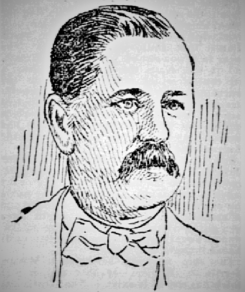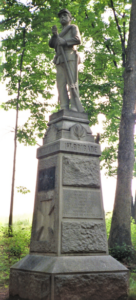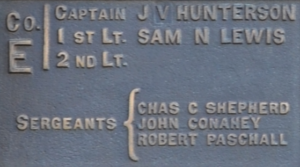Title: Army 1st Lieutenant, Civil War; real estate assessor, brick manufacturer
Birthdate: November 24, 1844
Death Date: December 16, 1918
Plot Location: Section 33, Lot 15

His was the oldest family in West Philadelphia, according to a newspaper account of the late 1800s. An ancestor received a grant from England’s King Charles II in the late 1600s for a large tract of land west of the Schuylkill River. Much of “Paschallville” was in family hands into the mid-1800s, when the name was eventually shortened by one letter to Paschalville.
The Paschalville Library pays tribute to the name and is still located at 70th and Woodland Ave. since it opened in 1915. It is just one block up from Paschal Ave. that runs (with a few interruptions) from Island Ave. to north of 47th and Grays Ferry Ave. Today, Paschalville is considered part of the larger Elmwood Park neighborhood.
A Military Life
Robert’s parents, Henry and Adeline, raised four boys and three girls on a farm, but none wanted to carry on the agricultural tradition. Robert heard about a recruitment drive for soldiers, so he joined Company E of the 118th Pennsylvania Infantry Regiment, enlisting as a corporal on August 2, 1862.
The 118th was held in reserve during the Battle of Antietam that fall, but a few days later at Shepherdstown it suffered a loss of 282 men out of 800. After that, Robert was promoted to Sergeant. That was followed by engagements at Fredericksburg and Chancellorsville with heavy casualties, but the Battle of Gettysburg was much less intense for them.
After that, Robert was promoted to Sergeant. That was followed by engagements at Fredericksburg and Chancellorsville with heavy casualties, but the Battle of Gettysburg was much less intense for them.
At right is the monument to the 118th at Gettysburg. The huge Pennsylvania Monument, shown here,  honors every Pennsylvanian who participated in that battle. Robert’s name is on the 118th Regiment’s bronze plaque as one of three sergeants.
honors every Pennsylvanian who participated in that battle. Robert’s name is on the 118th Regiment’s bronze plaque as one of three sergeants. 
The rest of the war was spent in Virginia as part of the Wilderness Campaign, the Battle of Spotsylvania Courthouse, and duty in Southern Virginia, where he was promoted to First Lieutenant. Robert was at Appomattox to witness the surrender of General Robert E. Lee’s Confederate forces.
A Family Life
After the war Robert was soon living on his own after his father moved to a farm in Chester County. He knew before he left for the war that there was a new cemetery just north of Paschallville, and that it attracted a lot of attention when the remains of Betsy Ross were moved there. What attracted Robert’s attention after the war was the daughter of the cemetery’s co-founder. Whatever the circumstances for their first meeting, romance was soon in bloom.
Emily Pennock Connell was just 23 days older than Robert, born on November 1, 1844. Her father was in his third term as a State Senator, and she never knew life without a servant. Robert, meanwhile, was working as a clerk in a flour mill. Her family was one of the pillars of St. James Kingsessing, an Episcopal Church at 68th and Woodland Ave. She and most of her 12 siblings were baptized there. Robert’s church background is unknown.
Proving his devotion to God and to Emily, the church records show that Robert was “confirmed” at St. James on June 26, 1870, essentially an adult’s re-affirmation of his faith. They were married there on November 1, the day Emily turned 26. Their home was with her parents at 60th and Kingsessing Ave. which was known then as Darby Road. Less than a year later, George Connell died, and the Paschalls remained with Emily’s mother until she died in 1899.
The couple welcomed four children over the next ten years, all baptized at St. James. Sadly, only one outlived the parents. She was Elizabeth, named after Emily’s mother. One daughter died in 1882 at age 8 and their son died at 22 in 1901. A third daughter became a medical doctor and was married with three children when she died at age 41 in 1911.
A Business Life
In 1875, Robert was appointed to became one of the city’s real estate assessors, holding that position for 20 years. When he left he had a comfortable middle-class income of $2000 a year, equivalent to $73,000 today. However, it wasn’t his only job.
Taking a page from his in-laws who knew the potential of good real estate investments, Robert became a partner in a brick manufacturing firm in 1882. The southwestern and southeastern corners of Philadelphia were rich sources of high-quality clay, making the city a preeminent brickmaking center. It was a lucrative business because the raw material was right there in the ground. The biggest expense was the labor to dig, mold, and dry it.
Robert’s investment, Equitable Brick Works, soon had three separate locations. After the first ten years, the company had made 125 million bricks. Equitable faced over 70 other competitors when it started, but there was plenty of work for everyone. Wave after wave of immigrants made South and Southwest Philly blossom with row home construction. By 1899, Philly’s brickyards were producing a combined 200 million bricks every year.
when it started, but there was plenty of work for everyone. Wave after wave of immigrants made South and Southwest Philly blossom with row home construction. By 1899, Philly’s brickyards were producing a combined 200 million bricks every year.
City directories list Robert’s title there as superintendent in the years before and after 1890, then as either general manager or president. By 1910 the Paschalls and their daughter Elizabeth moved to a rented house for a brief period of time. As he withdrew from business, a thickened heart muscle was making it harder to pump blood (hypertrophic cardiomyopathy) so they moved to Swarthmore, Delaware County, where Elizabeth bought a home.
Emily died in July of 1918 and Robert moved that September to the National Home for Disabled Soldiers in Tennessee. After admission he was diagnosed with arteriosclerosis, mitral insufficiency, and sarcoma of the breast. He was transferred to another branch of the National Home in Hampton, Virginia on November 8, but the heartbeats stopped a month later.
Elizabeth presided over the deaths of both her parents, attended by two prominent families. She returned to her job as a bookkeeper until her death in 1932. All six of the Paschalls were buried here in Section 33 along with many members of the Connell family.

Support the Friends of Mount Moriah
Help us in our mission to restore and maintain the beautiful Mount Moriah Cemetery by donating to our cause or volunteering at one of our clean-up events.

